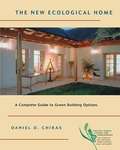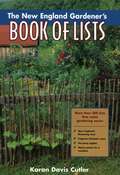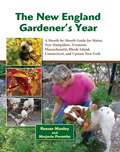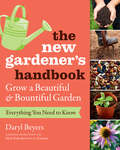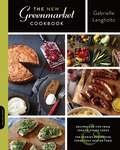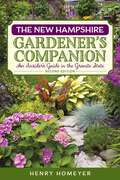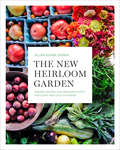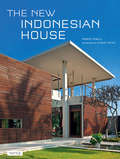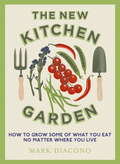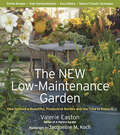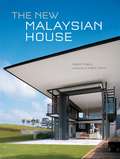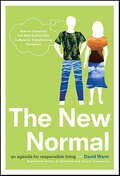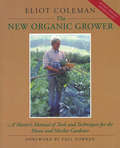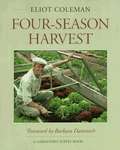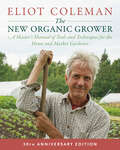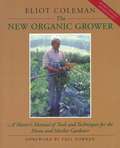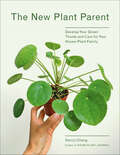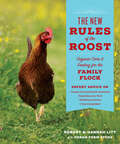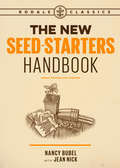- Table View
- List View
The New Design Rules: How to Decorate and Renovate, from Start to Finish: An Interior Design Book
by Emily Henderson Jessica Cumberbatch AndersonFrom the author of the New York Times bestseller Styled, here is Emily Henderson's masterclass on interior design. &“An approachable guide for anyone who is looking for tools and resources to create a home that speaks to who they are and what they love.&”—Joanna Gaines Whether you&’re embarking on a weekend refresh or complete renovation, interior designer Emily Henderson wants you to take risks with your home design without experiencing regret. In this visually driven decorating bible punctuated with photographs from real homes and colorful illustrations, she takes you through her entire process, including every single decision she makes when it comes to picking paint, arranging furniture, hanging window treatments, and deciding on lighting fixtures. You'll also learn when to hire a contractor versus an architect versus a handyperson, all the materials to consider (and why you might want to skip those marble countertops), proper measurements of the elements in each room, and so much more. By the end of the book, you'll feel more confident when it comes to visualizing the home of your dreams, and you'll finally know how to make it happen.
The New Ecological Home
by Daniel D. ChirasToday, a new generation of architects and builders is emerging, intent on creating homes that meet human needs for shelter while causing only a fraction of the environmental impact of conventional housing. "The New Ecological Home" provides an overview of green building techniques, materials, products, and technologies that are either currently available or will be in the near future. Author Daniel Chiras provides a wealth of up-to-date, practical information for home buyers, owner-builders, and anyone interested in building for a sustainable future. Included are chapters on: - The Healthy House - Green Building Materials - Wood-Wise Construction - Energy Efficiency - Earth-Sheltered Architecture - Passive Solar Heating and Passive Cooling - Green Power: Electricity from the Sun and Wind - Water and Waste: Sustainable Approaches - Environmental Landscaping
The New England Gardener's Book of Lists
by Karan Davis CutlerThe New England Gardener's Book of Lists contains essential information for anyone gardening in the unique climates of the upper northeast. This vital guide provides expert advice on choosing appropriate annuals, biennials, and perennials, tending bulbs, roses, shrubs, and vines, and selecting trees, native plants, ferns, grasses, and groundcovers for particular conditions.
The New England Gardener's Year: A Month-by-Month Guide for Maine, New Hampshire, Vermont. Massachusetts, Rhode Island, Connecticut, and Upstate New York
by Reeser Manley Marjorie PerontoThis comprehensive full-color what-to/when-to/how-to reference manual covers every garden and landscape planting including the most proven and popular as well as many native New England plants that deserve to be better known. Month-by-month guidance from March through October—with suggested dates for planting and tending adjusted for each zone—is augmented by advice on such topics as soil testing, composting, pruning, landscape design, and how to provide a season-long source of pollen and nectar for beneficial insects. Gardeners will find advice and photos for adapting to any microclimate or situation including shade; wet soil; coastal landscapes; container, raised-bed, and extended-season gardening; and much more. Gardeners and landscapers will treasure this book for its elegant writing and full-color photography, its photo-essay tours of outstanding owner-maintained gardens throughout New England, its focus on organic methods and native plants, and its guidance on integrating gardens of every variety into their surrounding landscapes. Photo sequences of key techniques enhance the book, which is designed and indexed to provide instant access to the information a gardener needs at hand. In Reeser Manley and Marjorie Peronto’s view, the plots of land on which we live are not our “yards” but our gardens—extensions of the surrounding natural world—and we, as gardeners, are caretakers of that world. They advocate gardening in tune with nature— avoiding pesticides, chemical fertilizers, and invasive plants, while creating a garden that enhances local biodiversity. The New England Gardener’s Year will guide you to a garden of great beauty and bountiful harvests.
The New England Gardener's Year: A Month-by-Month Guide for Maine, New Hampshire, Vermont. Massachusetts, Rhode Island, Connecticut, and Upstate New York
by Reeser Manley Marjorie PerontoGardeners will find advice and photos for adapting to any microclimate or situation including shade; wet soil; coastal landscapes; container, raised-bed, and extended-season gardening; and much more. Gardeners and landscapers will treasure this book for its elegant writing and full-color photography, its photo-essay tours of outstanding owner-maintained gardens throughout New England, its focus on organic methods and native plants, and its guidance on integrating gardens of every variety into their surrounding landscapes. Photo sequences of key techniques enhance the book, which is designed and indexed to provide instant access to the information a gardener needs at hand. In Reeser Manley and Marjorie Peronto's view, the plots of land on which we live are not our &“yards&” but our gardens—extensions of the surrounding natural world—and we, as gardeners, are caretakers of that world. They advocate gardening in tune with nature— avoiding pesticides, chemical fertilizers, and invasive plants, while creating a garden that enhances local biodiversity. The New England Gardener's Year will guide you to a garden of great beauty and bountiful harvests.
The New Gardener's Handbook: Everything You Need to Know to Grow a Beautiful and Bountiful Garden
by Daryl Beyers&“Gardeners just starting out will earn a sense of accomplishment and a good dose of knowledge.&” —Booklist Every new gardener has to start somewhere—and the process can be intimidating. Knowing when and what to plant, how to care for the plants once they&’re in the ground, and how to keep pests and diseases away is a lot to take on. Luckily, Daryl Beyers—an expert from the New York Botanical Garden—has written what will be a go-to resource for decades to come. The New Gardener&’s Handbook is a comprehensive overview of the fundamentals of gardening, based on the introductory gardening class that Beyers teaches at NYBG. Readers will learn about soil, plant selection, propagation, planting and mulching, watering and feeding, pruning, and weeds, pests, and diseases. The information applies to both ornamental and edible plants. Featuring inspiring photography and helpful illustrations, The New Gardener&’s Handbook gives home gardeners a foundation upon which they can grow, and encourages them to apply the lessons they&’ve learned in an intuitive, natural way.
The New Greenmarket Cookbook
by Gabrielle LangholtzFounded in 1976 with 12 farmers in a parking lot, New York's famed Greenmarket has now grown to become the largest and most diverse network of outdoor urban farmers' markets in the country, with 54 markets and more than 230 participating family farms, bakeries, and fishermen. Celebrated chefs have long touted the produce available at these markets, sourcing ingredients for some of their best dishes.Now,The New Greenmarket Cookbook brings to life the variety, flavor, and personal connections that have made the Greenmarket a culinary destination known the world over. Following the natural cycle of a year at the market, with chapters organized by season, the book offers easy, delicious restaurant recipes from the top chefs who frequent the stands for ingredients and inspiration.With full-color photos to illustrate the simple- yet- spectacular dishes-think sugar snap peas with mint, pavlova with strawberries, basil cider-braised pork shoulder, dandelion greens salad, cantaloupe and hyssop popsicles, and lemon thyme panna cotta--The New Greenmarket Cookbook is a gorgeous, flavorful journey through a bountiful year at the Greenmarket.
The New Hampshire Gardener's Companion: An Insider's Guide to Gardening in the Granite State (Gardening Series)
by Henry HomeyerThe New Hampshire Gardener&’s Companion is the only guide focused on the challenges of cultivating a successful garden in the Granite State. Whether you are an experienced green thumb or an inquiring novice, whether you live in the White Mountains, the Connecticut or Merrimac River valleys, or along the seacoast, this easy-to-understand guide will help you grow bountiful vegetables, abundant flowers, and lush lawns.
The New Heirloom Garden: Designs, Recipes, and Heirloom Plants for Cooks Who Love to Garden
by Ellen Ecker OgdenDesign a beautiful and self-sufficient garden; learn the secrets of heirloom vegetables, herbs, and flowers; and enjoy 55 seasonal recipes featuring the fruits of your labor--all with one book!Heirlooms are more than just delicious ingredients or beautiful flowers--their seeds offer us a connection with the earth, and each one tells a story. Author and garden lecturer Ellen Ecker Ogden was inspired to preserve the diversity of plants that are slipping away after learning that we have lost over 85% of the plant world in the last century to extinction.In The New Heirloom Garden, Ogden inspires us with a history of seed saving in this country, then guides gardeners of all levels to create their own heirloom gardens with tangible gardening tips, twelve themed garden designs, and detailed resources. The first half of the book shares specific garden plans, plant keys with descriptions, plant and seed wish lists, interviews with gardening experts, and even tips and tricks to handle your own local weather. The second half of the book contains 55 recipes for delicious entrees, sides, drinks, and desserts that can be made from each vegetable, fruit, and flower grown in your garden. Readers will delight in making Fennel and Watermelon Salad, Cucumber Summer Soup, Fire Cider, and Winter Squash Pie. It's a book designed for readers to bring to their local supply store, take outside into the garden, and then enjoy in the kitchen.
The New Indonesian House
by Robert Powell Albert Lim KsThe New Indonesian House presents twenty-eight homes in Jakarta, Bandung, Yogyakarta and Bali that illustrate the remarkable advances that have taken place in residential design in Indonesia over the last two decades. Indonesia's new generation of architects demonstrates not only their Absorption of modern influences from the West and the more recent processes of globalization but also their sensitivity to the physical environment, the social context and the aspirations of the leading elite. With its stunning color photographs, The New Indonesian House will both delight and inspire the application of its exhilarating architectural expressions in any global setting.
The New Indonesian House
by Robert Powell Albert Lim KsThe New Indonesian House presents twenty-eight homes in Jakarta, Bandung, Yogyakarta and Bali that illustrate the remarkable advances that have taken place in residential design in Indonesia over the last two decades. Indonesia's new generation of architects demonstrates not only their Absorption of modern influences from the West and the more recent processes of globalization but also their sensitivity to the physical environment, the social context and the aspirations of the leading elite. With its stunning color photographs, The New Indonesian House will both delight and inspire the application of its exhilarating architectural expressions in any global setting.
The New Kitchen Garden: How to Grow Some of What You Eat No Matter Where You Live
by Mark DiaconoWhether you are taking your first steps in growing some of what you eat, or experienced and looking for inspiration, ideas and some new plants to grow, The New Kitchen Garden is for you. Inspired by a range of gardeners growing food on allotments, on rooftops, in container gardens and in other edible spaces, many of them urban, Mark shows you the full exciting breadth of what a kitchen garden can be. Whether you have a window sill, space for a few plants by the back door, an allotment or an acre, you'll find a series of invitations to grow any of almost 200 fruits, nuts, herbs, spices, flowers and vegetables to suit your space, time and inclination. Everything is here - the tools, the techniques, the ideas and the knowledge - to enable you to realise that vision of your own kitchen garden, wherever you live. There's also a dozen incredible edible gardens - a rooftop food forest, a courtyard of metre-square raised beds, Charles Dowding's no-dig garden, a child's container garden and Raymond Blanc's heritage garden at Le Manoir among them - their gates flung open by the gardeners to reveal their methods, ideas and techniques, with plans, key plants and photography to accompany. Mark Diacono - who was head of the gardening team at Hugh Fearnley-Whittingstall's River Cottage - captures the spirit of adventure and imagination of those growing food in the twenty-first century. He takes ideas from gardens around the world, including that of his own home, Otter Farm in Devon, with its unique blend of orchards, vineyards, forest gardens, edible hedges, perennial garden and veg patch.No matter whether you have space for a collection of pots or a small farm at your disposal, The New Kitchen Garden will show you how to create the most incredible edible garden you can.
The New Kitchen Garden: The Ultimate Kitchen Garden Guide
by Mark DiaconoLook over the fences into the gardens, patios, courtyards and allotments behind, and you'll see a quiet revolution taking place. Amongst the lawns, the roses and the concrete, more and more of us are growing at least some of what we eat. A kitchen garden can be anything from a collection of pots to a small farm - it all depends on where you live and what space you have to create your own edible plot. The New Kitchen Garden doesn't begin with the usual plan of an allotment quartered into beds awaiting their rotation, it starts by asking what you need from your garden. What follows is a series of invitations - fruits, nuts, herbs, spices, flowers and vegetables to grow and eat. Everything is here - the tools, the techniques, the ideas and the knowledge - to enable you to realise that vision of your own kitchen garden. Mark Diacono - who was head of the gardening team at Hugh Fearnley-Whittingstall's River Cottage - captures the spirit of adventure and imagination of those growing food in the twenty-first century. He takes ideas from gardens around the world, including that of his own home, Otter Farm in Devon, with its unique blend of orchards, vineyards, forest gardens, edible hedges, perennial garden and veg patch. Inspired by a range of gardeners growing food on allotments, on rooftops, in container gardens and in other edible spaces, many of them urban, Mark shows you the full exciting breadth of what a kitchen garden can be. Whether you have a few pots of chillies or a community farm, whether you wish to plant in ordered rows or create an edible jungle, The New Kitchen Garden is for you.
The New Low-Maintenance Garden: How to Have a Beautiful, Productive Garden and the Time to Enjoy It
by Valerie Easton Jacqueline Knox Jacqueline M. KochDo you ever lament that you'd love to be able to garden more, but just don't have the time? The demanding pace of modern life leaves little space for the pleasures of gardening. On the other hand, gardening itself could be the culprit: elaborate, traditional perennial borders; water-hungry or disease-prone plants; needy lawns; and high-maintenance plants that require staking or clipping all suck up precious hours. Simply put, we need to start gardening in a whole new way. In this inspiring book, Val Easton shows exactly how to have a low-maintenance garden that doesn't sacrifice style. You won't have to give up your favorite plants or settle for expanses of ugly bark nuggets. You just have to unlearn some bad old habits and pick up some good new ones. So, how do you go about making a "new" low-maintenance garden? First, design your garden with maintenance in mind—good-looking hardscape will both save weeding time and showcase your favorite plants. Second, simplify your garden routines—learn the most efficient planting and maintenance techniques and don't get stressed if everything isn't letter-perfect. Third, learn how to work with nature rather than against it. And finally, embrace home-grown fruits, herbs, and vegetables; well planted containers; and thoughtfully chosen plants.The New Low-Maintenance Garden doesn't just tell you how to garden in a whole new way—it shows you, through profiles and beautiful photographs of real gardens that embody low-maintenance techniques. The pressures of life are not likely to ease up anytime soon, but the lessons of this timely book will help you banish guilt over undone garden chores and revel in your garden successes.
The New Luxury: Individuality, quality and sustainability in interior design
by Dean KeyworthThis book explores what 'luxury' in interior design means today and how to achieve it, and provides inspirational examples of projects from a range of designers that meet the parameters of quiet luxury. Like many other sectors, interior design can be polarised: the luxury, unattainable end, and the cheap and cheerful lower end.This book disregards this dichotomy and shows how designers can avoid a throw-away culture, cleaving to that idea of longevity and high-quality above the cheap and flimsy, even for those with smaller budgets. Illustrated with beautiful examples of projects, this is a book that showcases how interior designers and homeowners alike can achieve an interior space that prioritises quality and sustainability on every kind of budget, focusing on quality fabrics and materials, sustainable credentials and complementary tones.
The New Malaysian House
by Robert Powell Albert Lim KsThe New Malaysian House is a collection of 25 contemporary houses that demonstrate a remarkable flowering of Malaysian design talent that has been germinating since the mid- 1980s. The houses range from luxury detached bungalows set in extensive tropical gardens to weekend retreats in the forest, from the gated communities springing up throughout Malaysia to extended family homes. All are distinguished by a singular quality of innovative design as the architects sought to explore new approaches for designing with the climate and in the cultural context of Malaysia.
The New Malaysian House
by Robert Powell Albert Lim KsThe New Malaysian House is a collection of 25 contemporary houses that demonstrate a remarkable flowering of Malaysian design talent that has been germinating since the mid- 1980s. The houses range from luxury detached bungalows set in extensive tropical gardens to weekend retreats in the forest, from the gated communities springing up throughout Malaysia to extended family homes. All are distinguished by a singular quality of innovative design as the architects sought to explore new approaches for designing with the climate and in the cultural context of Malaysia.
The New Normal: An Agenda for Responsible Living
by David WannIn Simple Prosperity, Dave Wann showed readers how to have an abundant, sustainable life. In The New Normal, he challenges us to do some heavy lifting and transform our non-sustainable culture by transforming ourselves. For Wann, our current "old normal" lifestyle - buying water in disposable bottles, allowing the government to ignore global warming - will not preserve the planet. To nurture our world, he challenges us to rethink our lives, stand up for a healthy planet and move towards a "new normal" lifestyle in an agenda that includes:- Initiating local business alliances that actively lobby for local buying.- Creating an investment strategy that values the balance of nature.- Supporting the design, manufacture, and use of products made with natural chemicals.- Publicly advocating a more efficient use of water by placing a higher cultural value on wetlands, streams, rivers, and lakes.The New Normal is Dave Wann's way forward, a blueprint for a better life that preserves our world.
The New Organic Grower
by Eliot ColemanWith more than 45,000 sold since 1988, The New Organic Grower has become a modern classic. In this newly revised and expanded edition, master grower Eliot Coleman continues to present the simplest and most sustainable ways of growing top-quality organic vegetables. Coleman updates practical information on marketing the harvest, on small-scale equipment, and on farming and gardening for the long-term health of the soil. The new book is thoroughly updated, and includes all-new chapters such as:•Farm-Generated Fertility-how to meet your soil-fertility needs from the resources of your own land, even if manure is not available. •The Moveable Feast-how to construct home-garden and commercial-scale greenhouses that can be easily moved to benefit plants and avoid insect and disease build-up. •The Winter Garden-how to plant, harvest, and sell hardy salad crops all winter long from unheated or minimally heated greenhouses. •Pests-how to find "plant-positive" rather than "pest-negative" solutions by growing healthy, naturally resistant plants. •The Information Resource-how and where to learn what you need to know to grow delicious organic vegetables, no matter where you live. Written for the serious gardener or small market farmer, The New Organic Grower proves that, in terms of both efficiency and profitability, smaller can be better.
The New Organic Grower's Four-Season Harvest: How To Harvest Fresh, Organic Vegetables From Your Home Garden All Year Long
by Eliot ColemanEveryone who grows vegetables must know Coleman. He's the organic methods expert--the one who knows how to maximize both garden yield and gardening pleasure, year round. Annotation c. by Book News, Inc. , Portland, Or.
The New Organic Grower, 3rd Edition: A Master's Manual of Tools and Techniques for the Home and Market Gardener, 30th Anniversary Edition
by Eliot Coleman&“Updated for its 30th anniversary edition [this book] remains as relevant as ever.&”—New York Times Book ReviewSince its original publication in 1989, The New Organic Grower has been one of the most important farming books available, with pioneer Eliot Coleman leading the charge in the organic movement in the United States. Now fully illustrated and updated, this 30th Anniversary Edition is a must-have for any agricultural library.Eliot Coleman&’s books and innovative methods have helped innumerable organic farmers build successful farms in deep accordance with nature. The wisdom in this seminal book holds true even as the modern agricultural canon has grown—in large part due to Coleman&’s influence as a wise elder with decades of experience. New information has been included in this edition to showcase the new tools and techniques that Eliot has been developing over the last thirty-five years.Inspired by the European intensive growers, The New Organic Grower, 30th Anniversary Edition, offers a very approachable and productive form of farming that has proven to work well for the earth and its stewards for centuries. Gardeners working on 2.5 acres or less will find this book especially useful, as it offers proof that small-scale market growers and serious home gardeners can live good lives close to the land and make a profit at the same time. The New Organic Grower is ideal for young farmers just getting started, or gardeners seeking to expand into a more productive enterprise.New material in this edition includes:Beautiful color photographs throughout, taken by master gardener and author Barbara Damrosch (Eliot&’s wife and co-farmer)Updated information throughout on how Eliot&’s practices have changed through his experiments over the yearsA new section from Damrosch about incorporating flowers on the small farmMore information on new tools Eliot has invented that don&’t appear in any of his other books&“I was interested in the environment, farming, science . . . and there was Eliot&’s book lying on the shelf. I remember grabbing it, and I just FELL IN. . . . I remember reading it like it was the Bible.&”—Dan Barber, chef
The New Organic Grower: A Master's Manual of Tools and Techniques for the Home and Market Gardener
by Eliot ColemanThe simple way to growing top-quality organic vegetables.
The New Plant Parent: Develop Your Green Thumb and Care for Your House-Plant Family
by Darryl ChengThe creator of Instagram&’s House Plant Journal mixes love with scientific logic in this beautifully photographed guide for indoor gardeners. For indoor gardeners everywhere, Darryl Cheng offers a new way to grow healthy house plants. He teaches the art of understanding a plant&’s needs and giving it a home with the right balance of light, water, and nutrients. With this book, indoor gardeners can be less a passive follower of rules for the care of each species and much more the confident, active grower, relying on observation and insight. And in the process, the plant owner becomes a plant lover, bonded to these beautiful living things by a simple love and appreciation of nature. The New Plant Parent covers all of the basics of growing house plants, from finding the right light, to everyday care like watering and fertilizing, to containers, to recommended species. Cheng&’s friendly tone, personal stories, and accessible photographs fill his book with the same generous spirit that has made @houseplantjournal, his Instagram account, a popular source of advice and inspiration for over half a million indoor gardeners.
The New Rules of the Roost: Organic Care and Feeding for the Family Flock
by Hannah Litt Robert Litt“The Litts listen daily to concerns and questions posed by customers seeking the best organic methods for keeping backyard chickens safe and healthy. Now they’ve compiled their proven solutions into this often-entertaining book.” —Gail Damerow, author of The Guide to Raising Chickens New from Robert and Hannah Litt—the authors of the bestselling A Chicken in Every Yard—comes a hardworking guide to backyard chicken keeping that goes beyond the basics. The New Rules of the Roost addresses the real problems that crop up when keeping chickens long term. The Litts cover a wide range of topics including organic health remedies and disease prevention, pest management, organic nutrition, the best breeds for specific needs, and the simplest options for daily maintenance and feeding. You'll also learn tips and tricks for introducing new birds into your flock, managing aggressive behavior, caring for mature chickens, and much more.
The New Seed-Starters Handbook (Rodale Organic Gardening)
by Nancy Bubel Jean NickStarting plants from a seed grants earlier harvests, greater variety, healthier seedlings, lower costs, and the undeniable sense of satisfaction and reward. For the most complete, up-to-date information on starting plants from seed, turn to The New Seed-Starter's Handbook. Written by a gardener with 30 years of experience, this updated, easy-to-use reference explains everything you need to know to start seeds and raise healthy seedlings successfully. You'll find:- The latest research in seed starting- The best growing media- The newest gardening materials- Solutions to seed-starting problems- Source lists for seeds and hard-to-find gardening suppliesThe robust encyclopedia section lists more than 200 plants—including vegetables and fruits, garden flowers, wildflowers, herbs, trees, and shrubs—with details on how to start each from seed.

